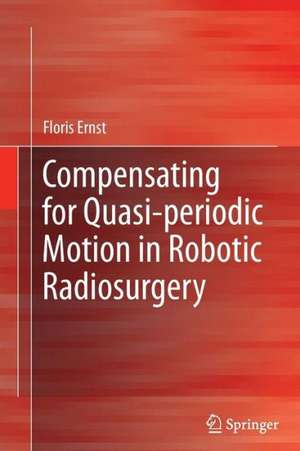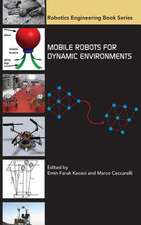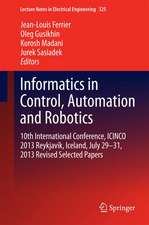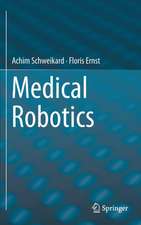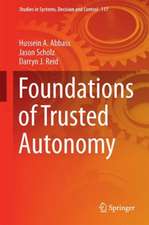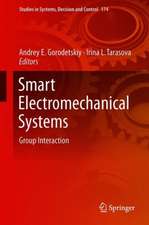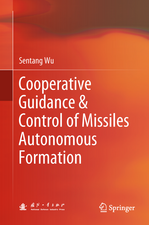Compensating for Quasi-periodic Motion in Robotic Radiosurgery
Autor Floris Ernsten Limba Engleză Paperback – 25 ian 2014
In Chapters 1 and 2, the book introduces the concept of stereotactic body radiation therapy, motion compensation strategies and the clinical state-of-the-art. In Chapters 3 through 5, the author describes and evaluates new methods for motion prediction, for correlating external motion to internal organ motion, and for the evaluation of these algorithms’ output based on an unprecedented amount of real clinical data. Finally, Chapter 6 provides a brief introduction into currently investigated, open questions and further fields of research.
Compensating for Quasi-periodic Motion in Robotic Radiosurgery targets researchers working in the related fields of surgical oncology, artificial intelligence, robotics and more. Advanced-level students will also find this book valuable.
| Toate formatele și edițiile | Preț | Express |
|---|---|---|
| Paperback (1) | 557.45 lei 38-44 zile | |
| Springer – 25 ian 2014 | 557.45 lei 38-44 zile | |
| Hardback (1) | 644.82 lei 6-8 săpt. | |
| Springer – 17 noi 2011 | 644.82 lei 6-8 săpt. |
Preț: 557.45 lei
Preț vechi: 696.80 lei
-20% Nou
Puncte Express: 836
Preț estimativ în valută:
106.68€ • 110.21$ • 88.79£
106.68€ • 110.21$ • 88.79£
Carte tipărită la comandă
Livrare economică 22-28 martie
Preluare comenzi: 021 569.72.76
Specificații
ISBN-13: 9781489995285
ISBN-10: 1489995285
Pagini: 256
Ilustrații: XI, 244 p. 139 illus.
Dimensiuni: 155 x 235 x 13 mm
Greutate: 0.37 kg
Ediția:2012
Editura: Springer
Colecția Springer
Locul publicării:New York, NY, United States
ISBN-10: 1489995285
Pagini: 256
Ilustrații: XI, 244 p. 139 illus.
Dimensiuni: 155 x 235 x 13 mm
Greutate: 0.37 kg
Ediția:2012
Editura: Springer
Colecția Springer
Locul publicării:New York, NY, United States
Public țintă
ResearchCuprins
Introduction.- Motion Compensation in Robotic Radiosurgery.- Signal Processing.- On the outside: prediction of human respiratory and pulsatory motion.- Going inside: correlation between external and internal respiratory motion.- Conclusion.- Appendix.
Notă biografică
Floris Ernst was born on August 6th, 1981, in Hinsdale, Illinois/USA. He studied Mathematics at Friedrich-Alexander-University (Erlangen, Germany) and at the University of Otago (Dunedin, New Zealand).
He graduated from the University of Otago in 2004 with a Postgraduate Diploma in Sciences (Mathematics). In 2006, he graduated From Friedrich-Alexander-University with a Diploma in Mathematics, minoring in Computer Sciences. From 2006 on he held a position as a research associate at the University of Lübeck’s Institute for Robotics and Cognitive Systems, where he worked on motion compensation strategies in robotic radiosurgery. He graduated from this university with a Ph.D in 2011.
He graduated from the University of Otago in 2004 with a Postgraduate Diploma in Sciences (Mathematics). In 2006, he graduated From Friedrich-Alexander-University with a Diploma in Mathematics, minoring in Computer Sciences. From 2006 on he held a position as a research associate at the University of Lübeck’s Institute for Robotics and Cognitive Systems, where he worked on motion compensation strategies in robotic radiosurgery. He graduated from this university with a Ph.D in 2011.
Caracteristici
Describes in great detail the technology behind the advanced motion compensation algorithms used in radiotherapy Explores cutting-edge, new algorithms for motion prediction and correlation Surveys an unprecedented amount of clinical data, in order to emphasize the relevancy and necessity for new algorithms in radiosurgery Includes supplementary material: sn.pub/extras
